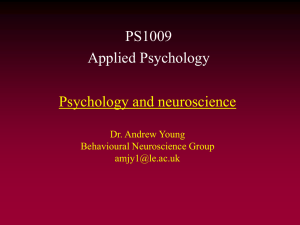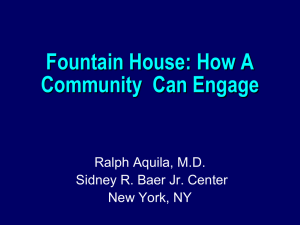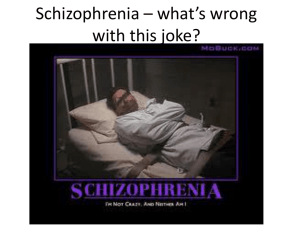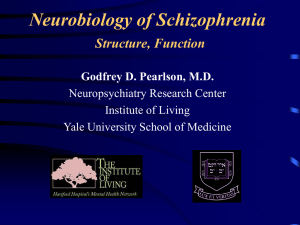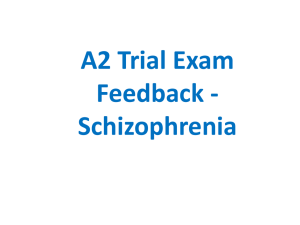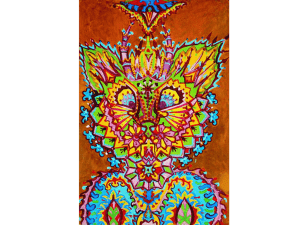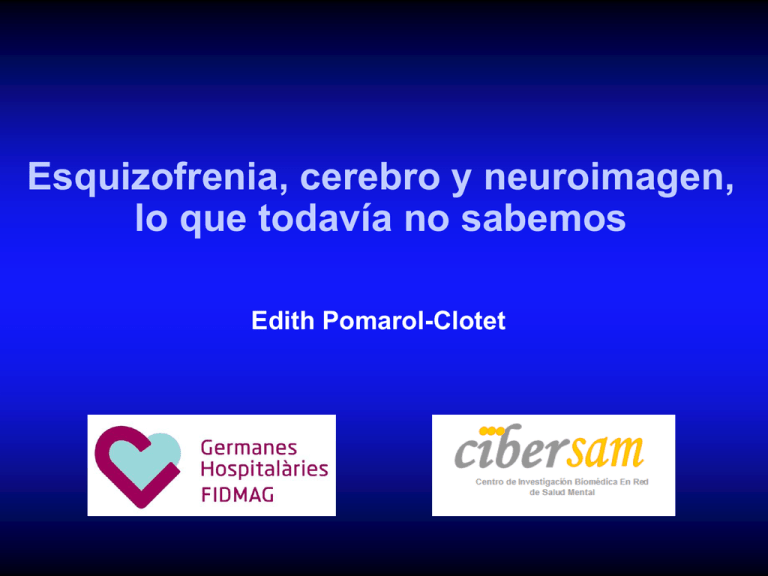
Esquizofrenia, cerebro y neuroimagen,
lo que todavía no sabemos
Edith Pomarol-Clotet
What has brain imaging contributed
to schizophrenia research?
‘Since the advent of modern neuroimaging techniques,
the number of studies of the pathophysiological
changes of schizophrenia has dramatically increased,
with more than 1000 reports published in the past 10
years.
Structural brain imaging studies have shown a subtle,
almost universal, decrease in grey matter, enlargement
of ventricles, and focal alteration of white matter
tracts.’
fMRI studies show abnormalities in the brain response
to cognitive tasks, with an abnormal network response
characterised by both hyperactivity and hypoactivity in
different brain regions.’
(van Os & Kapur, the Lancet, 2009)
Imaging approaches to
schizophrenia
Structural brain abnormality
– CT and MRI brain imaging
– Voxel-based morphometry (VBM)
– Diffusion tensor imaging (DTI)
Functional brain abnormality
– Functional imaging at rest
– Functional imaging during task performance
– Connectivity analysis
Biochemical abnormality
– Imaging of dopamine neuronal function
– Imaging of glutamate neuronal function (not yet
performed in schizophrenia)
Structural brain imaging in
schizophrenia
The first generation - CT
First CT study found enlarged
lateral ventricles
– But small sample of institutionalized
pts
(Johnstone et al, 1976)
Larger study confirmed
enlargement
– Small in degree
– Only detectable visually in 10% of
cases
(Weinberger et al, 1979)
Subsequent studies
– Almost all find enlargement
– Present at onset of illness, does not
progress
– ie is ‘neurodevelopmental’ in nature
(Harrison, 1999)
Structural imaging studies
The second generation - MRI
Meta-analysis of 31 studies
Lateral ventricles
– 26% bigger (30 studies)
Whole brain
– 2% smaller (31 studies)
Frontal lobes
– 5% smaller (13 studies)
Temporal lobes
– 2.5% smaller (25 studies)
Hippocampus/amygdala
– 5-9% smaller (15 studies)
Also
– 2% for gray matter reduction and
1% white matter reduction
(Wright et al, 2000)
Structural imaging studies
Emerging themes
Progression
of brain structural changes
– Is there a neurodegenerative process in addition to the
neurodevelopmental ?
Voxel
based structural analysis
– Where are the grey matter changes localized?
Diffusion
tensor imaging
– Are white matter tracts affected?
Multimodal
imaging
– Do grey and white matter findings converge?
Does brain structural abnormality
in schizophrenia progress?
Meta-analysis of 27 studies,
follow-up 1-10 years.
´Subjects with schizophrenia
showed significantly greater
decreases over time in whole
brain volume, whole brain gray
matter, frontal gray and white
matter, parietal white matter,
and temporal white matter
volume, as well as larger
increases in lateral ventricular
volume.’
Difference/year
–
–
–
–
-.07% whole brain volume
-.59% whole brain gray matter
-.32% frontal white matter
+.35% lateral ventricles
(Olabi et al, 2011)
Voxel-based morphometry
Voxel-Based Morphometry (VBM) permite la
comparación,
voxel-a-voxel
(VOlume
ELement), de la concentración de materia de
los tipos de tejido entre dos grupos de sujetos.
(Ahora se puede medir el volumen en vez de la
concentración)
Análisis de todo el volúmen cerebral, no
requiere asumir ROIs a priori.
VBM permite representar sobre los mapas,
zonas o clusters de deterioro o crecimiento
del tejido asociado a un grupo de sujetos con
respecto al otro.
Fig. 1.1- Mapa parametrico estadístico
resultante en un estudio de VBM.
1
Meta-analysis of VBM studies in
schizophrenia
Anterior cingulate/medial
prefrontal cortex bilaterally
Posterior cingulate gyrus
Middle and inferior
frontal gyri
Insula/operculum
bilaterally
(Fornito et al, 2009)
Diffusion tensor imaging
Water molecules in
white matter move
more easily along the
axonal bundles than
perpendicular to them
This ‘anisotropy’ can
be measured using MRI
(‘fractional anisotropy,
FA)
FA is reduced in
disorders affecting
white matter integrity
Can use tractography
algorithms to delineate
affected tracts
Diffusion tensor imaging
Water molecules in
white matter move
more easily along the
axonal bundles than
perpendicular to them
This ‘anisotropy’ can
be measured using MRI
(‘fractional anisotropy,
FA)
FA is reduced in
disorders affecting
white matter integrity
Can use tractography
algorithms to delineate
affected tracts
Multimodal structural imaging in
schizophrenia
‘The meta-analyses
revealed overlapping GM
and WM structural
findings in
schizophrenia,
characterized by
bilateral anterior cortical,
limbic and subcortical
GM abnormalities, and
WM changes in regions
including tracts that
connect these
structures...’
(Bora et al, 2011)
Red: grey matter, Green: white matter, Blue: DTI
Functional imaging studies
The first generation - hypofrontality
First study documented
‘hypofrontality’
– Reduced prefrontal metabolism at rest
(Ingvar & Franzen, 1974)
Not well-replicated subsequently
– Found in only 10/27 well-designed
studies
(Chua & McKenna, 1995)
Hypofrontality more easily
demonstrated during performance
of a ‘frontal’ task
(Weinberger et al, 1988)
Hypofrontality in schizophrenia
- a meta-analysis
1.5
No. of
Total N
1.0
(d)
studies
Resting hypofrontality
Effect size
38
1474
-0.32
0.5
25
950
-0.55
0.0
(relative)
Resting hypofrontality
d
(absolute)
Activation hypofrontality
17
685
-0.37
-0.5
10
347
-0.42
-1.0
(relative)
Activation hypofrontality
(absolute)
-1.5
-2.0
Acute (N=8) Mixed (N=14)Chronic (N=20)
(Hill et al, 2004)
Functional imaging studies
The second generation – hypo- and
hyperfrontality
‘Although patients
with schizophrenia
engaged the DLPFC
less than comparison
subjects, they
overactivated a
portion of the
anterior cingulate.’
(Glahn et al, 2005)
Meta-analysis of 12 studies
using the n-back task
An fMRI study of working
memory in schizoprenia
32 chronic
schizophrenic patients
32 controls matched for
age, sex WAT-estimated
IQ
Scanned while
performing 1 and 2 back
versions of the n-back
task
– + baseline task of viewing
sequence of asterisks
– 1.5T scanner
– Blocked design
(Pomarol-Clotet et al, 2008)
Tarea de N-BACK
AP
1-BACK
FF
KP
P
Tarea de N-BACK
AP
2-BACK
FP
KK
UP
U
APF
FKP
P
APF
PKK
UPU
Psychology
Physics
-32
-26
-20
-14
-8
-2
4
10
16
22
28
34
40
46
52
58
Statistics
Contrasting experimental stimuli cause changes in local brain blood supply which are measured
by rapid, repeated measurements of MR signal, and statistically mapped onto brain anatomy
Dorsolateral hypo- and
ventromedial hyperfrontality…
Controls > Schizophrenics
-32
-26
-20
-14
-8
-2
4
10
16
16
22
22
28
28
34
34
40
40
46
46
52
52
58
58
Schizophrenics > Controls
-32
-26
-20
-14
-8
-2
4
10
16
22
28
34
40
46
52
58
…or failure of deactivation in the
medial prefrontal cortex?
Controls
-32
-26
-20
-14
-8
-2
4
10
16
22
28
34
40
46
52
58
Schizophrenics
-32
-26
-20
-14
-8
-2
4
10
16
22
28
34
40
46
52
58
Functional imaging studies
Emerging themes
Failure
of de-activation/Default mode
network dysfunction
Is
there overlap between structural and
functional abnormality?
Altered
functional connectivity
The default mode network
A network of brain regions discovered
in 2001
Have in common that they are active at
rest but de-activate during
performance of most cognitive tasks
– Also activates during performance of a
small number of certain tasks
Includes as ‘hubs’ two midline regions
– Anterior: medial PFC/ACC
– Posterior: PCC/precuneus
(Gusnard et al, 2001; Raichle et al, 2001;
Greicius et al,2003)
What does the default mode network do?
The
default network is active when
individuals are engaged in internally focused
tasks including autobiographical memory
retrieval, envisioning the future, and
conceiving the perspectives of others.
May
also have a role in low-level monitoring
of the external world for unexpected events,
ie an exploratory state or ‘watchfulness’.
(Buckner et al, 2008)
Failure of de-activation more
marked in first-episode patients
who have, or progress to,
schizophrenia
Is DMN dysfunction specific to
schizophrenia?
29 manic pts vs 46 controls
(Pomarol-Clotet et al, 2011)
41 bipolar depressed pts vs 41
controls
(Fernández-Corcuera et al, in press)
44 euthymic pts vs 44 controls
(Pomarol-Clotet et al, in preparation)
Multimodal imaging in 32
schizophrenic patients and 32 controls
fMRI
Blue – reduced activation
Orange – failure of de-activation
Voxel-based morphometry
(Pomarol-Clotet et al, 2010)
DTI and tractography findings
DTI
Tractography
Functional connectivity in
schizophrenia
‘Neuroimaging has opened up the black box
of the brain so that mental disorders can, for the
first time, be studied as abnormalities in the connections
between distant areas of the brain or, in some cases,
problems in the coordination of brain areas whose activity is
normally synchronized….the latest research shows that the
malfunctioning of entire circuits may underlie many
mental disorders.’
Connectivity in schizophrenia
Most studies find
evidence of reduced
connectivity in
schizophrenia
(Petterson-Yeo, et al, 2011)
Studies of resting
state/DMN connectivity
are divided between
those finding
decreased and
increased connectivity
– Often implicate the
medial frontal cortex
(Salgado-Pineda et al,
2011)
Significantly increased connectivity
in the medial frontal cortex in 32
chronic schizophrenic patients
compared to 32 controls
(Salvador et al, 2010))
Conclusions
The
anterior cingulate cortex/medial frontal
cortex is a region of topical interest in
schizophrenia
– As well as the dorsolateral prefrontal cortex
DMN
dysfunction is an increasingly wellestablished finding
– Not specific to schizophrenia, also seen in other major
psychiatric disorders
Emerging
theme is overlap between structural
and functional brain abnormality in
schizophrenia
– And perhaps other disorders
Muchas gracias
Peter J. McKenna
Raimon Salvador
Salvador Sarró
Gemma Monté
Erick J. Canales
Jesús Gomar
Maria Anguera
Amalia Guerrero
Paloma Fernandez-Corcuera
Noemi Moro
Elena rodríguez-Cano
Benedikt Amann
José M. Goikolea (HC)
Eduard Vieta (HC)
Bibiana Sans-Sansa
Silvia Alonso
Teresa Maristany (SJD)
Ramón Landín
Jordi Ortiz-Gil
Especialmente a nuestros pacientes
Is DMN dysfunction also found
in other psychiatric disorders?
Major
affective disorder
– Yes both phases of bipolar disorder, and euthymia
(Pomarol-Clotet 2010), Fernández-Corcuera, under review)
– Yes unipolar major depression
(Sheline et al, 2009, Rodríguez-Cano, unpub)
Delusional
disorder
– Present in similar area to schizophrenia
(Vicens et al, submitted)
The default mode network
A
network of brain regions which is active at
rest but de-activates during performance of
most cognitive tasks
Especially two ‘midline’
– Anterior: medial PFC/ACC
– Posterior: PCC/precuneus
regions
Currently
believed to carry out operations
related to ‘self’
– Theory of mind, recollection of autobiographical
memories, planning for future, ‘stimulus-independent’
thought, etc
(Gusnard et al, 2001; Greicius et al, 2003;
Gusnard, 2005)
Andreasen’s study of ventricular
size in schizophrenia
18
Patients (N=101)
Controls (N=60)
16
Large sample
14
12
No of 10
patients
8
Enlargement confirmed
6
4
2
0
0
1
2
3
4
5
6
7
8
9
Ventricle-brain ratio
10 11 12 13 14
Well matched for age,
sex, education
Small in degree
Overlap with wide
normal range
Functional brain imaging with
task activation
‘Prefrontal
hypometabolism in
schizophrenia is most
apparent during, and
perhaps dependent upon,
circumstances in which
there is demand for
specific prefrontal
function’
(Weinberger, 1988)
Functional imaging:
voxel-based studies
Some
studies continue to find hypofrontality
– Most studies use task activation
Three
influential studies found hyperfrontality
– No hypofrontality (Sternberg task)
(Manoach et al, 1999)
– Plus areas of hypofrontality (n-back task)
(Callicott et al, 2000, 2003)
Hyperfrontality
supported by meta-analysis
– ‘Although we find clear support for hypofrontality, we
also document consistently increased activation in
anterior cingulate and left frontal pole regions in patients
with schizophrenia compared to that in controls.’
(Glahn et al, 2005; Minzenberg et al, 2010)
Weinberger’s interpretation of
hyperfrontality
Working harder to keep up
‘…the results of these
studies suggest that when
patients are able to keep up
with the processing
demands, they tend to do
so less efficiently by
engaging greater cerebral
metabolic activity or a less
focused cortical activity
state….
…at least part of the
increased or intact
activation might serve to
compensate for some
underlying neural
dysfunction, even as the
overall network
architecture might be
inefficient.’
(Tan et al, 2007)
Schizophrenics
Controls
fMRI response
Hyperfrontality
Hypofrontality
Working Memory Load
(Callicott et al, 2003)
Other psychotic disorders: Delusional disorder
18 patients with delusional disorder vs 36 controls
Failure to de-activate
Resting state connectivity
VBM
(Vicens et al, submitted)
Is DMN dysfunction a state or trait
marker in schizophrenia?
Related to chronicity?
– Present in chronic schizophrenia
(eg Pomarol-Clotet el al, 2008)
– Present in early course schizophrenia
(Whitfield-Gabrieli et al, 2009)
– Present in first-episode patients
(Guerrero et al , 2010)
Related to schizophrenic symptoms?
– Yes (especially positive symptoms)
(Liang et al, 2006; Bluhm et al, 2007;
Whitfield-Gabrieli et al (2009)
– No (no association with any class of symptoms)
Pomarol-Clotet et al (2008)
Present in relatives of schizophrenic pts?
– Yes Whitfield-Gabrieli et al (2009)
Neurochemical imaging in
schizophrenia
The dopamine hypothesis
– Functional excess of dopamine causes positive symptoms
(delusions, hallucinations) of schizophrenia
– Strongly supported by circumstantial evidence
» Dopamine agonists (eg amphetamine) provoke psychosis
» All antipsychotic drugs work by blocking dopamine
receptors
– But direct evidence of dopamine receptor increases in drugnaive patients negative
The glutamate hypothesis
– Functional deficiency of glutamate causes positive and negative
symptoms (apathy, emotional withdrawal)
– Equivocally supported by circumstantial evidence
» Glutamate antagonists (eg PCP) cause psychotic symptoms
» Glutamate agonists do not improve positive or negative
symptoms
– Some support from PM brain studies
An alternative interpretation of
hyperfrontality
Failure of de-activation
a
+
Activation
In the first instance (a), the
task of interest has a
greater increase above
baseline than the control
task.
In the second instance (b),
the task of interest has
less of a decrease from
the baseline.
In both cases, the
difference in activity
between the control task
and the task of interest
would be interpreted as an
increase.
0
Baseline
Control task Task of interest
-
b
+
Activation
Baseline
Control task Task of interest
0
-
(Gusnard & Raichle, 2001)
Is there DMN dysfunction in
schizophrenia?
Study
Measure
Task
DMN de-
Connectivit
activation
y
Related to
Anterior
Posterior
Resting state
-
-
↓
Positive symptoms
Liang et al.
fMRI
(2006)
parcellation
Bluhm et al.
fMRI ROI
Resting state
-
-
↓
Positive symptoms
fMRI ICA
Oddball
↑
↓
-
-
fMRI ROI
Resting state
-
-
↑
-
fMRI
Oddball
↑
↑
-
Emotional awareness
(2007)
Garrity et al.
(2007)
Zhou et al.
(2007)
Harrison et al.
(2007)
Pomarol Clotet et al.
of others
fMRI
N-back
↓
Neither symptoms
(2008)
Kim et al.
nor cognition
fMRI
Sternberg
↓
?
fMRI
N-back
↓
-
(2009)
Whitfield-Gabrieli et
↑
al (2009)
Calhoun et al.
Positive and negative
symptoms
fMRI
Oddball
N/A
N/A
-
-
(2008)
(updated from Broyd et al, 2009)
‘Many
illnesses previously defined as
“mental” are now recognized to have a
biological cause….schizophrenia is now
viewed and treated as a developmental brain
disorder.’
(Insel, 2010)


